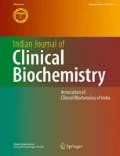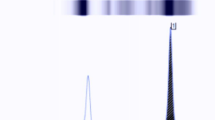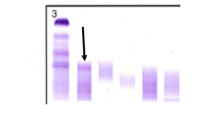Abstract
Paraproteinemia is characterised by clonal proliferation of plasma cells. A common laboratory finding in paraproteinemia being a monoclonal peak in serum protein electrophoresis (M band). But there are factors which produce a peak similar to M spike in serum protein electrophoresis and these factors are known as pseudoparaproteins. This case report discusses a rare cause of pseudo M spike in a known case of autoimmune hemolytic anaemia due to administration of drug-Rituximab, a monoclonal antibody by itself.



Similar content being viewed by others
Abbreviations
- AIHA:
-
Autoimmune hemolytic anemia
- CZE:
-
Capillary zone electrophoresis
- Ig:
-
Immunoglobulin
- k:
-
Kappa
- MAT:
-
Monoclonal antibody therapy
- CD:
-
Cluster of differentiation
- LOS:
-
Length of stay
References
Cook L, Macdonald D. Management of paraproteinaemia. Postgrad Med J. 2007;83(978):217–23.
Rajkumar S. Multiple myeloma: 2012 update on diagnosis, risk-stratification, and management. Am J Hematol. 2012;87(1):78–88.
Strobel S. The incidence and significance of pseudoparaproteins in a community hospital. Ann Clin Lab Sci. 2000;30(3):289–94.
Pescovitz M. Rituximab an anti-CD20 monoclonal antibody: history and mechanism of action. Am J Transpl. 2006;6(5p1):859–66.
Ruinemans-Koerts J, Verkroost C, Schmidt-Hieltjes Y, Wiegers C, Curvers J, Thelen M, et al. Interference of therapeutic monoclonal immunoglobulins in the investigation of M-proteins. Clin Chem Lab Med. 2014;52(11):235–7.
McCudden C, Axel A, Slaets D, Dejoie T, Clemens P, et al. Monitoring multiple myeloma patients treated with daratumumab: teasing out monoclonal antibody interference. Clin Chem Lab Med. 2016;54(6):1095–104.
McCudden C, Voorhees P, Hainsworth S, Whinna H, Chapman J, Hammett-Stabler C, et al. Interference of monoclonal antibody therapies with serum protein electrophoresis tests. Clin Chem. 2010;56(12):1897–904.
Author information
Authors and Affiliations
Corresponding author
Ethics declarations
Conflict of interest
None of the authors of this study have any conflict of interest.
Ethical Approval
This article contains study with a human participant performed by the authors. Informed consent was obtained from the individual participant included in the study.
Rights and permissions
About this article
Cite this article
Chakravarthy, S.N., Ramanathan, S., Menon, S. et al. Cinderella in Serum Protein Electrophoresis. Ind J Clin Biochem 33, 113–116 (2018). https://doi.org/10.1007/s12291-017-0643-8
Received:
Accepted:
Published:
Issue Date:
DOI: https://doi.org/10.1007/s12291-017-0643-8




